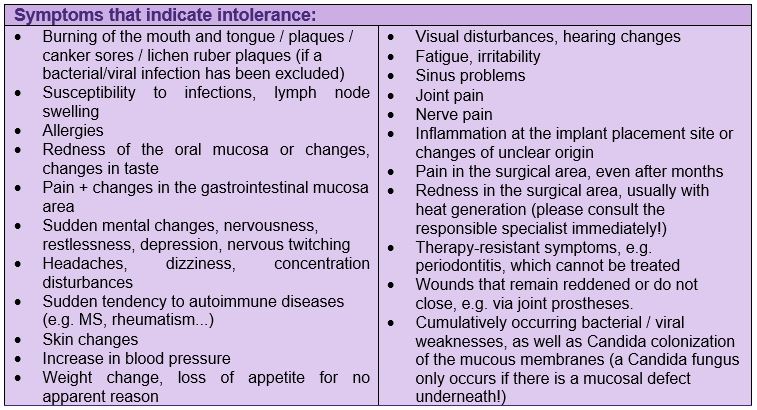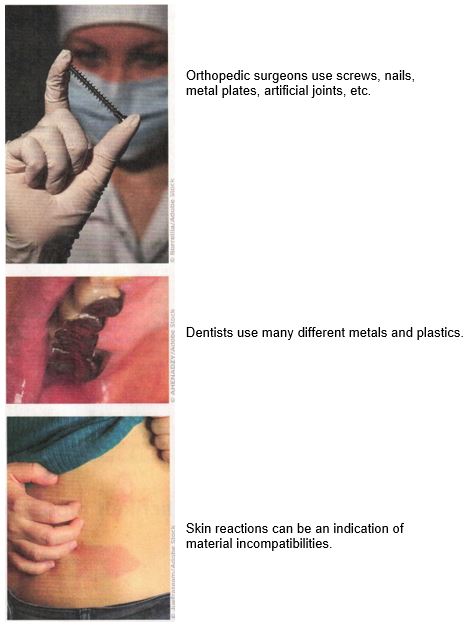Health
Foreign Materials In The Body
How We Can Avoid Allergies and Chronic Diseases
Allergies, inflammations, chronic complaints – how do you find out whether input exogenous materials are the reason for this? And is it really effective to remove the materials? Studies and practical experience encourage those affected.
By Carola D’Mexis (Hp.), Mannheim
In the last ten years, allergic reactions have increased to such an extent that one in three German citizens now suffers from sensitivity disturbances of the skin, mucous membranes or respiratory tract. In view of this development, it can be assumed that the corresponding hereditary patterns will also be increasingly passed on by parents. Additionally, there are burdens from food, the environment and also vaccinations.
Even in the womb, the embryo can come into contact with toxins. After birth, breast milk may pass on harmful substances to the infant, such as mercury from amalgam fillings. After all, children and adults are directly confronted with harmful substances such as preservatives, admixtures of heavy metals in vaccines, such as mercury (until 2009) or aluminum hydroxide (currently). Subsequently, food intolerances can develop with a tendency to allergic and toxic reactions to these substances, and also chronic diseases.
Individual Anamnesis
When a patient comes to the practice with allergies, it is important to first take a careful medical history: Each patient has their own medical history, their own allergens and their own psychological stress that promotes or triggers problematic chemical processes in the body. In order to determine the therapeutic approach, it is necessary to identify which exogenous materials were used. For example, dental materials, endoprostheses, pacemakers, piercings, implants and much more should be considered. Additionally , it is necessary to ask which foods effect the respective person, whether they are particularly exposed to certain environmental pollutants, whether there have been occupational contaminations and what the hereditary predisposition is. In principle, more distant periods must also be taken into account when searching for triggers. This is because allergies can occur in immediate reactions, late reactions (within 7 to 78 hours) and very late reactions, for example after months or years; even if the body has constant contact with the allergen. Sometimes a mental event is enough to trigger allergies, as it has caused an immune deficiency.

The Search For The Cause
How do you find out whether exogenous materials are the cause of this in patients who are affected health-wise?

In the meantime, the insertion of implants is the order of the day in a wide variety of medical sectors. Dentists replace tooth substance with a wide variety of materials, orthopedic surgeons install artificial joints, and heart surgeons provide patients with pacemakers. Cochlear implants are used for severe hearing loss, breast implants are used after breast cancer and permanent acupuncture needles are even used in naturopathy.
In principle, there is not a single dental material or exogenous material that is free of allergy or intolerance risks. But every person has an individual compatibility.
There are several possibilities to find out whether present symptoms were triggered by inserted exogenous materials.
First of all, it must be determined whether the affected person shows signs of inflammation or other abnormalities, such as pain, skin changes or a tendency to disease, after the introduction of the foreign exogenous material.
Further information can be provided by special examinations from environmental medicine, blood tests, saliva tests or epicutaneous skin tests. However, an epicutaneous skin test only reacts in about ten percent of cases. Energetic procedures such as Kinesiology and EAV (Electro-Acupuncture According to Voll) are often not reproducible procedures and depend on the tester and his health. These test procedures are suitable as a pre-test.
Important Testing Methods
There are the following scientifically recognized compatibility tests of exogenous materials, which can be used for dental materials, for example:
- LTT blood test (or: lymphocyte transformation test), suitable for testing allergies to individual dental materials, for example to methyl methacrylate or palladium. (Late reaction). Allergy ID is created.
- LTT blood test, suitable for tooth material mixtures, e.g. gold alloys, prostheses, plastics, cements, fillings, inlays, etc. No allergy ID is created here.
- BAT blood test, suitable for plastics, not for metals (immediate reaction).
- SALLERGO saliva test. This can be used to test the oral environment as well as material samples. The special thing about this test is that it checks the interaction of different materials. The possible materials in question are placed in the mouth at the relevant point as finished solid mixtures in the final processing state and finally together (e.g. crown framework-facing-cement). If the result is positive, material reactions with each other are excluded.
70 percent of all chronic diseases can be triggered by environmental pollutants and exogenous materials.
Focus On Dentistry
Dentists are confronted more and more often with patients being allergic to certain materials and developing chronic inflammatory diseases. This means that they meet patients with disturbed immune tolerance (for example, allergy sufferers). This is significant, because dentists in particular are forced to permanently introduce foreign materials into the bodies of their patients. Dental restorative [denture] materials are particularly in focus compared to environmental influences or food, because they have a permanent effect: 24 hours a day, 7 days a week.
Dr. med. Volker von Baehr and I have dealt more intensively with this topic (see book tip). Our results, collected since 1994, showed conspicuous reactions to metals, which often only became noticeable quite late, after weeks. Physical and/or mental changes began here within a few days up to three months after contact with the materials. On the other hand, after using plastics we often found immediate reactions.

Symptoms of plastics and metals
Metals used in dentistry to date include amalgam components, gold alloys, zirconium oxide, and base metals. These produce changes in the oral mucosa and can also reach the entire body via the gastrointestinal tract if the intestinal mucosa is not intact, which is often the case (leaky gut syndrome). Metals are permeable with the brain and placenta. Due to an allergic or oxidative reaction, the metals react pathologically and damage tissue, nerves and organs. Undesirable reactions to introduced plastics are mucosal complaints with gastrointestinal involvement and leaky gut generation (intestinal permeability). However, extensive scientifically recognized studies have shown that the symptoms can be regulated if problematic materials have been removed.
7,000 patients who had been diagnosed with such a material intolerance benefited significantly when the problematic dental material was replaced by a compatible alternative. After removal and drainage of the problematic materials, a wide variety of diseases were regulated within three weeks to six months.
Result
For good diagnostics and therapy, the faculties of classical, scientific medicine and the associated laboratories, as well as the therapists of Naturopathy and empirical medicine, should work more closely together. The patient is the focus and through the joint possibilities should receive optimal assistance for their concerns. We would like to motivate practices and clinics to preventively test foreign exogenous materials for their individual compatibility. Precisely on the basis of our daily experience, we would like the described material tests to be applied in the correct order. The allergy test procedures, even if the materials have been approved and found to be good, should always be carried out on every patient. In order to prevent recourse, court disputes and also acts of desperation by many injured patients who are looking for solutions, validated tests and the diagnoses and consultations derived from them should also be paid for by the statutory health insurance companies – private health insurance companies often already cover the costs. This could prevent many chronic diseases – not only concerning the teeth – which could avoid immense follow-up costs.

An Exclusive Translated Article for P2P Supporters
From the Monthly Publications of P2P
Published March 2025
From an article in raum&zeit, Volume 43, Issue 253, Jan/Feb 2025
Translation & redaction by: Carolyn L. Winsor, P2P Consulting
© Copyright 2025, raum&zeit, Carola D’Mexis, Germany
Digital and online translation assistance utilized.

Book Tip:
Carola D’Mexis: „Zahnmaterialien ihre Wirkung auf Körper Kopf und Psyche”, MGO-Verlag, 2019, 34,95 €, ISBN 978-3964742087
Sources:
- D’Mexis: „Zahnmaterialien ihre Wirkung auf Körper Kopf und Psyche”, MGO-Verlag,
https://shop.mgo-fachverlage.de/zahnmaterialien-ihre-wirkung-auf-korper-kopf-und-psyche.html - Kramer: „Gesundheitsstörungen durch Amalgam und Mundbatterien”, Arbeitskreis für ganzheitliche Diagnostik, Herdgeschehen und Bio-Therapie. Nürnberg, 1992
- Kramer: „Über die Bedeutung von Zusammensetzung und Verarbeitung zahnärztlicher Metalle für deren Verträglichkeit”, Berichte aus dem Arbeitskreis für ganzheitliche Diagnostik, Herdgeschehen und Bio-Therapie, Nürnberg, 1994
- Peesel. F. Kramer: „Amalgam, Mundbatterien und das Grundsystem”, Pfeiffer-Verlag, Hersbruck, 1995
- Maes: „Stress durch Strom und Strahlung”, Schriftenreihe gesundes Wohnen, Institut für Baubiologie, Naubeuern, 1992
- Metalle und Subtoxische Belastungen neu bewertet. In: Umwelt-Medizin-Gesellschaft ,Vereinsorgan der Verbände dbu, DEGUZ, DGUHT, EUROPAEM, IGUMED und KMT, 1/24
Further information on this topic:
- Forschung zu Metallen: Eleonore Blaurock-Busch: https://microtrace.de/de/metalle-krankheiten-forschung/
- Endoprothesenunverträglichkeit: https://www.imd-berlin.de/spezielle‑kompetenzen/metallbelastung/belastung-aus-endoprothesen
- LTT + BAT Zahnmaterialtestung: https://www.imd-berlin.de/fachinformationen/diagnostikinformationen/ltt-nachweis-von-sensibilisierungen-gegenueber-zahnersatzmaterialien-mittels-lymphozytentransformationstest
- Sallergo-Speicheltest: https://www.dental-diagnostik.de/services/sallergo-speicheltest/
- Zahnmaterial-Testvorgang: https://allergo-dental.de/ Seite PDF-Datei
- Umweltschadstoffe: D. Meissner-Institut f. klinische Chemie, Toxichem Krimtech 2020;87(3)120 https://www.gtfch.org/cms/images/stories/media/tk/tk87_3/Meissner_2020_v2.pdf



